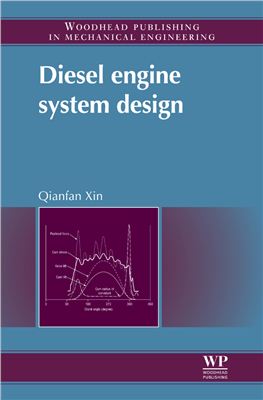Woodhead Publishing, 2011. 1088 p.
ISBN 978-1-84569-715-0 (print)
ISBN 978-0-85709-083-6 (online)
The diesel engine has been recognized as the most promising powertrain of the foreseeable future due to its superior thermal efficiency and reliability. Mode emission standards and customer demands have increased the need for advanced design theories for diesel engines. By focussing on engine performance and system integration, this book establishes the theory of diesel engine system design, including the approaches used in its modelling and analysis. Diesel engine system design links everything diesel engineers need to know about engine performance and system design in order to master all the essential topics quickly and apply the techniques to solve practical design problems.
Part one provides detailed coverage of the fundamental concepts and generic techniques in diesel engine system design. It starts with the analytical design process followed by the theories on durability, reliability and optimization. Part two goes on to present the fundamentals of dynamic and static diesel engine system designs by introducing engine thermodynamic cycle and vehicle powertrain performance, followed by the critical boundary conditions for engine system design in the areas of combustions, emissions and aftertreatment. Part three explores dynamics, friction and NVH (noise, vibration and harshness), including a comprehensive coverage on valvetrain and piston assembly. Part four proceeds with thermodynamic first and second law analyses on heat rejection and air system including EGR and turbocharging, followed by transient performance and engine controls before summarizing subsystem interaction and system specification design.
With its distinguished author Diesel engine system design will benefit a broad range of engineering professionals in different disciplines and provide them with a systematic understanding of how engine system design specifications are generated. It will also introduce engine design knowledge to academic researchers and enable system design engineers to directly apply the methods and working knowledge to their daily design and research.
ISBN 978-1-84569-715-0 (print)
ISBN 978-0-85709-083-6 (online)
The diesel engine has been recognized as the most promising powertrain of the foreseeable future due to its superior thermal efficiency and reliability. Mode emission standards and customer demands have increased the need for advanced design theories for diesel engines. By focussing on engine performance and system integration, this book establishes the theory of diesel engine system design, including the approaches used in its modelling and analysis. Diesel engine system design links everything diesel engineers need to know about engine performance and system design in order to master all the essential topics quickly and apply the techniques to solve practical design problems.
Part one provides detailed coverage of the fundamental concepts and generic techniques in diesel engine system design. It starts with the analytical design process followed by the theories on durability, reliability and optimization. Part two goes on to present the fundamentals of dynamic and static diesel engine system designs by introducing engine thermodynamic cycle and vehicle powertrain performance, followed by the critical boundary conditions for engine system design in the areas of combustions, emissions and aftertreatment. Part three explores dynamics, friction and NVH (noise, vibration and harshness), including a comprehensive coverage on valvetrain and piston assembly. Part four proceeds with thermodynamic first and second law analyses on heat rejection and air system including EGR and turbocharging, followed by transient performance and engine controls before summarizing subsystem interaction and system specification design.
With its distinguished author Diesel engine system design will benefit a broad range of engineering professionals in different disciplines and provide them with a systematic understanding of how engine system design specifications are generated. It will also introduce engine design knowledge to academic researchers and enable system design engineers to directly apply the methods and working knowledge to their daily design and research.

